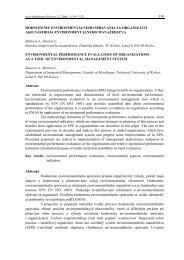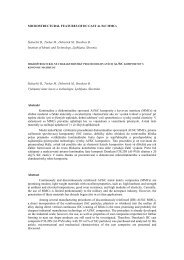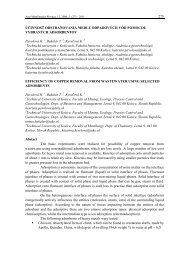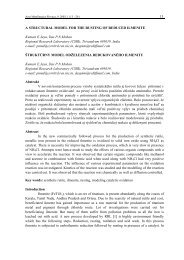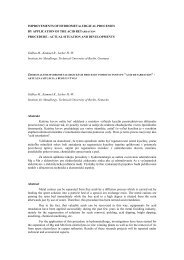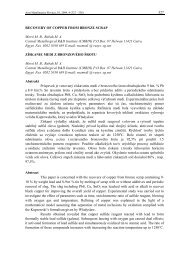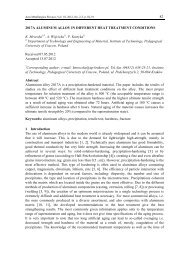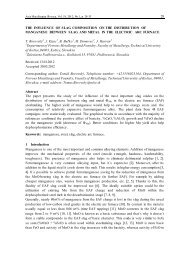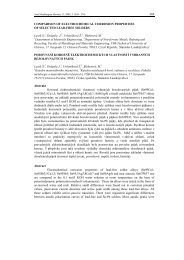mag07.pdf (150 kB) - Acta Metallurgica Slovaca - TUKE
mag07.pdf (150 kB) - Acta Metallurgica Slovaca - TUKE
mag07.pdf (150 kB) - Acta Metallurgica Slovaca - TUKE
Create successful ePaper yourself
Turn your PDF publications into a flip-book with our unique Google optimized e-Paper software.
<strong>Acta</strong> <strong>Metallurgica</strong> <strong>Slovaca</strong>, 15, 2009, 2 (117 - 125) 117<br />
DESIGN AND VERIFICATION OF THE MATHEMATICAL MODEL<br />
FOR DETECTING THE THROUGHPUT OF THE COMPRESSOR STATIONS<br />
Vaszi ZS. , Varga A.<br />
Department of Furnaces and Thermal Technology, Faculty of Metallurgy, TechnicalUniversity<br />
in Košice, Slovakia<br />
NAVRHNUTIE A OVERENIE MATEMATICKÉHO MODELU PRE ZISTENIE<br />
PRIEPUSTNOSTI KOMPRESOROVEJ STANICE<br />
Vaszi ZS. , Varga A.<br />
Katedra pecí a teplotechniky, Hutnícka fakulta, Technická univerzita Košice, Slovensko<br />
Abstrakt<br />
V čase hospodárskej krízy sa dostáva do popredia úspora plynu aj pri jeho preprave.<br />
KS1 – Veľké Kapušany je hlavnou preberacou stanicou, kde ruský plyn vstupuje do Slovenskej<br />
republiky, a preto jeho priepustnosť je veľmi dôležitý pre celý tranzit. V uplynulom roku<br />
EUSTREAM a.s. prepravilo viac ako 76, 2 miliard metrov kubických zemného plynu. Aj keď<br />
táto spoločnosť udržuje dôležitú pozíciu v rámci európskych prepravných systémov je veľmi<br />
dôležitá efektívna preprava takéhoto množstva zemného plynu. V čase keď už dodávka zemného<br />
plynu z východného smeru nie je viac samozrejmosťou ešte viac vstupuje do popredia úspora<br />
deného plynu či už pri preprave, alebo pri distribúcii. Príspevok sa zaoberá priepustnosťou<br />
jednotlivých kompresorových agregátov v závislosti od vstupných parametrov, ako aj návrhom<br />
matematickeho modelu, a prepisom daného modelu do programu. Výstupy z programu sa dajú<br />
využiť pre vytváranie kombinácie prevádzkovaných kompresorových agregátov. Pomocou<br />
tohto programu je možné zistiť aj vplyv teploty plynu na prepravné parametre jednotlivých<br />
agregátov. Výsledkom riešenia je analýza priepustnosti vybraných druhov strojov pri<br />
zabezpečovaní požiadavky na dopravu denného objemového množstva plynu v rozsahu od 110<br />
do 230 mil.m 3 v závislosti od vstupného tlaku, kompresného pomeru, teploty okolia ako aj<br />
sledovanie vplyvu teploty plynu na prepravu plynu.<br />
Riešenie danej problematiky sa napíšu do troch bodov:<br />
• Analýza pracovných charakteristík všetkých strojov, ktoré sú predmetom vzájomnej<br />
spolupráce a ich spracovanie do matematických vyjadrení.<br />
• Definovanie optimálnych pracovných režimov jednotlivých strojov.<br />
• Vyhodnotenie priepustnosti jednotlivých agregátov.<br />
Abstract<br />
In the time of the economic crisis the saving of gas in its transport had came to the<br />
forefront. The main taking – over station is KS1 – Veľké Kapušany, where Russian gas enters<br />
the Slovak Republic, and therefore the throughput is very important for the entire transit.<br />
Eustream a.s. transported more than 76,2 billion cubic meters of natural gas in last year.<br />
Although the company maintains an important position in European transport systems is a very<br />
important the effective transport of this natural gas quantity. At a time when the natural gas is<br />
not supplies from the eastern direction is more obvious to saving gas, whether in transport or<br />
distribution. The paper describes the throughput of each compressor set, depending on the input
<strong>Acta</strong> <strong>Metallurgica</strong> <strong>Slovaca</strong>, 15, 2009, 2 (117 - 125) 118<br />
parameters, as well as design of the algorithm and mathematical approach in form of software.<br />
This software can be used for creating the combination of operating compressor aggregates.<br />
With this software it is possible to detect the effect of temperature on gas transport parameters of<br />
the individual aggregates. Results of the analysis is the permeability of certain types of<br />
machinery to ensure the requirements for the transport of gas daily mass in the range from 110<br />
to 230 mil.m 3 according to the input pressure, compression ratio, the ambient temperature as<br />
well as monitoring the impact of temperature of gas in gas transport.<br />
The solution of the problem is described in the following three points:<br />
• Analysis of the working characteristics of all machines that are the subject of mutual<br />
cooperation, and their incorporation into mathematical terms.<br />
• Defining the optimal working regimes of the individual machines.<br />
• Evaluation of the permeability of different aggregates<br />
Key words: Compressor station, mathematical model, throughput, compressor set<br />
1. Introduction<br />
Turbo compressors are not work under the conditions for which they were designed,<br />
i.e. under conditions, which are reflected in the design of the flow cross-section, blade angles<br />
and so on. It is obvious that, depending on the factors that affect the operation of the compressor<br />
changed will be the compression and efficiency. Compression, efficiency and input power vary<br />
depending on the parameters of the inlet gas. The parameters of the inlet gas have major impact<br />
on the overall throughput of compressor stations.<br />
2. Characteristics of compressor stations<br />
There are 4 compressor stations representing the major technological complexes in<br />
the mutual distance of about 115 km in the transit pipeline on the territory of the Slovak<br />
Republic. Characteristics of the individual stations with the number of aggregates are given in<br />
Tab 1.<br />
Table 1 Distribution and number of aggregates<br />
Major technological<br />
Veľké Kapušany<br />
equipments<br />
Jablonov nad<br />
Turňou<br />
Veľké Zlievce<br />
Ivanka pri Nitre<br />
TS 6 MW 23 21 22 22<br />
ES 25 MW 3 3 3 -<br />
T 23 MW 1 1 2 4<br />
R 28 MW 3 2 - -<br />
These technological devices provide the required transport by increasing the pressure<br />
level to compensate the pressure loss in pipes and to ensure the contracted amount of pressure<br />
and transport of the natural gas to the border taking over points.<br />
Compression station KS1 - Veľké Kapušany is the most important point in the transit<br />
system in Slovakia and therefore its throughput determines the performance of the transit system<br />
of the Slovak Republic. Information about compressor aggregates are in Tab 2.
<strong>Acta</strong> <strong>Metallurgica</strong> <strong>Slovaca</strong>, 15, 2009, 2 (117 - 125) 119<br />
Table 2 Compressor aggregates<br />
Aggregates<br />
Range speed<br />
(sp.min -1 )<br />
Max usable<br />
speed.<br />
(sp.min -1 )<br />
Pursuit of<br />
the<br />
projected<br />
(MW)<br />
Max power<br />
Summer<br />
(MW)<br />
Winter<br />
(MW)<br />
Number of<br />
aggregates<br />
max.<br />
Immed<br />
use<br />
Maximum<br />
compression<br />
ratio<br />
GT750-<br />
6 MW<br />
3800 - 5600 5300 6 5,5 6 19 16 1,22 3)<br />
NP<br />
PGT 25<br />
3250 - 6500 6200 22,67 19 1) 20,5 1) 1 1 2) 1,46<br />
Cooper –<br />
Rolls<br />
3120 - 5050 4700 27,426 25 28 3 3 2) 1,7<br />
Electrical<br />
drives 2600 - 3900 3700 25 25 25 3 2 1,45<br />
GE ** 4250 - 6405 6300 34 3 1,75<br />
1)<br />
Restrictions on the quantity of emissions generated in the further improvement of performance exceed the limit sets<br />
2)<br />
Under operation may also be 3CR with 1NP, but in practice operate only 3 aggregates and one is left in reserve.<br />
3)<br />
In the two-stage operation the compression ratio is. 1.44 max.<br />
**) New aggregates in KS1<br />
3. Calculation of the throughput of different aggregates<br />
The problem of the aggregate sets in operation, depending on the required volume of<br />
gas transport through the compressor station, inlet gas pressure, the compression ratio and the<br />
ambient temperature, must be solved as the throughput of gas through the individual aggregates<br />
of KS and conditions of the operation of individual drives depending on the ambient<br />
temperature.<br />
To solute this problem, it is necessary to undergo subsequent steps:<br />
• to revise the characteristics of the individual aggregates and drives based on a graphic<br />
form according to the mathematical regression analysis using the software Fotofilter<br />
and Excel to create universal characteristics of individual aggregates:<br />
⎛<br />
⎜<br />
M ⋅ T<br />
ε = f<br />
⎜<br />
⎝<br />
P1<br />
1 ,<br />
n ⎞<br />
⎟<br />
T ⎟<br />
1 ⎠<br />
P k<br />
⎛ M ⋅ T<br />
= f ⎜<br />
⎜<br />
⎝<br />
P1<br />
1 ,<br />
⎞ ⎛<br />
n M ⋅ T<br />
⎟<br />
T ⎟<br />
⎟ ⎞<br />
⎜<br />
n<br />
η = f<br />
1 ,<br />
(1)<br />
k<br />
1 ⎠ ⎝ P1<br />
T1<br />
⎠<br />
and to determine the basic parameters of the drives.<br />
η = f ( P , n ) P f ( P ,η , t )<br />
t<br />
k<br />
t<br />
t<br />
= (2)<br />
k<br />
• to design the mathematical model for the calculation of the throughput of the individual<br />
aggregates under required output parameters at KS1, depending on the input<br />
parameters, p 1 , t 1 , t a of the individual aggregates,<br />
• to execute a simulations of the impact of the input parameters p 1 , T 1 , on the throughput<br />
of the individual aggregates at KS1,<br />
• to process data obtained from the simulations based on regression analysis into the<br />
polynomial dependencies:<br />
n = f ( q)<br />
P k<br />
= f ( q)<br />
P t<br />
= f ( q)<br />
e k<br />
= f ( q)<br />
f ( q)<br />
t<br />
ok<br />
e t<br />
= (3)
<strong>Acta</strong> <strong>Metallurgica</strong> <strong>Slovaca</strong>, 15, 2009, 2 (117 - 125) 120<br />
4. Algorithm of the program for calculation<br />
• input parameters p 1 , t 1 , ε, t ok<br />
• calculation of terms<br />
M<br />
x =<br />
min<br />
min<br />
.<br />
P<br />
1<br />
T<br />
1<br />
and<br />
M max. T<br />
1<br />
x<br />
max<br />
= (4)<br />
P1<br />
and other parameters of compressors and drives - P k , η k , n tt , η tt , P t e k , e tt for the given input<br />
parameters p 1 , t 1 ε, based on the polynomial equations for : ε, P k , P t,max , η k , n tt , e k , e tt .<br />
• adjustment of the above calculated x to q 20 ( gas throughput adjusted for t = 20 o C)<br />
• output data : data sets for the corresponding aggregates : i, n k , q 20, , P k, , η k, , n tt, , η t,t ,<br />
P tmax ,, e k ,, e tt ,
<strong>Acta</strong> <strong>Metallurgica</strong> <strong>Slovaca</strong>, 15, 2009, 2 (117 - 125) 121<br />
5. Acquisition of data sets in program EXCEL:<br />
Obtained data sets related to the constants n and Pk for compressors for variety of<br />
input pressures p 1 , compression ratios ε and ambient temperature ta are processed in<br />
program„Excel“ into the polynomial dependencies for each aggregate :<br />
3 2<br />
n = a q + b q + c q + d<br />
p<br />
p<br />
p<br />
p<br />
(5)<br />
and for each turbine:<br />
3 2<br />
P = a q + b q + c q + d<br />
k<br />
k<br />
k<br />
P = a q + b q + c q + d<br />
3 2<br />
;<br />
t, max t t t t tt<br />
k<br />
k<br />
; e<br />
k<br />
=Pk/q (6)<br />
e = Ptmax/q (7)<br />
Verification of the mathematical approach<br />
To be able to exploit the mathematical models for the simulations using the input<br />
parameters, it is necessary to verify the above based on the practical measurements at KS1<br />
provided in Tab.3.<br />
Table 3 Throughput KS1<br />
Measured data<br />
KS1<br />
Calculated data<br />
Q 0 P 1 P 2 T 1 P+R+E ČKD 6MW Q 0 del KS1<br />
(mil.m 3 /d)<br />
(20°C)<br />
(MPa) (°C) I II<br />
(mil.m 3 /d)<br />
(20°C)<br />
258,45 4,9 6,51 17 0+2+1 5 4 255 1,33<br />
248 4,5 6,19 17 0+2+1 5 4 248 0<br />
(%)<br />
Q 0<br />
P 1<br />
P 2<br />
T 1<br />
P p<br />
P k<br />
- natural gas volume related to the commercial conditions m3/d<br />
- gas input pressure at KS1 resp.KS2<br />
- gas output pressure at KS1 resp.KS2<br />
- gas input temperature at KS1 resp.KS2<br />
- output pressure from KS1<br />
- input pressure to KS2<br />
del_KS1 – difference between measured and calculated data of gas volume<br />
P+R+E: number of machines under operation (Pignone, Cooper, electro-drive, CKD)<br />
ČKD 6MW: number of machines under operation (CKD- 6MW) I – first level ; II – second level<br />
6. Results<br />
Gas transport and related energy consumption depend beside the parameters p 1 , ε and<br />
ta also on the input gas temperature t 1 , which lays within the range of 17 – 23 °C.<br />
Based on the above described procedures, executed were the calculations of<br />
temperature t 1 effect on the transported gas volume q, compressor capacity P k and capacity of<br />
turbine P t . Obtained results are given in Fig 1.
<strong>Acta</strong> <strong>Metallurgica</strong> <strong>Slovaca</strong>, 15, 2009, 2 (117 - 125) 122
<strong>Acta</strong> <strong>Metallurgica</strong> <strong>Slovaca</strong>, 15, 2009, 2 (117 - 125) 123<br />
Fig.1 Effect of input gas temperature on the transporting parameters of the compressor for p 1=5 MPa; ε=1,4<br />
Based on graphs analysis, it follows out that the input gas temperature does not effect<br />
essentially the transport parameters of the individual aggregates and therefore this temperature is<br />
not considered when calculated further the database and the calculations are executed for the<br />
input gas temperature t 1 = 20 °C.<br />
The described program provides the datasets as depending on p 1 , ε and t a..<br />
These datasets from program EXCEL defined may be the limits of the gas throughput<br />
for the individual aggregates operation (q min , q max ) and graphs :<br />
n, P k , P t = f(q) (8)<br />
for the corresponding input parameters p 1 , ε and t ok , expressed in form of the polynomial<br />
equations.
<strong>Acta</strong> <strong>Metallurgica</strong> <strong>Slovaca</strong>, 15, 2009, 2 (117 - 125) 124<br />
Fig.2 Energy nominal consumption of the compressor and turbine as depending on the natural gas throughput<br />
Based on the above graphs, it follows out that the energy nominal consumption of<br />
compressor or turbine, when defining the optimum combination of the co-operation of the<br />
individual machines in the requested amount of gas transport under defined input parameters p 1 ,<br />
ε and t ok, , in essentially affected by the energy consumption e t or e k . The most suitable variant<br />
is the combination of the aggregates with the lowest nominal energy consumption.<br />
Graph on the relationship e = f (q) provide the information that with the increased gas<br />
throughput the nominal energy consumption for all considered aggregates falls.<br />
7. Conclusion<br />
The aim of this article is to analyse the throughput of the compressor station KS1 –<br />
Veľké Kapušany and design of the suitable mathematical model. In the article described is the<br />
algorithm of the program, based on the mathematical description of the process. The above<br />
provided the tool by the aid of which determined could be the effect of the transported gas<br />
temperature upon the transport parameters of the individual aggregates. Designed mathematical<br />
model was verified and proved the inaccuracy up to 2 percent. Software Program based on the<br />
mathematical description of the process enables also to define the optimal combinations of<br />
aggregates for the daily transport of gas within the range of 110 to 230 mil.m 3 as depending on<br />
the entry pressure, compression ration and ambient temperature. The suitable optimum<br />
combinations of the aggregates in the compression station is necessary mainly due to the<br />
reduction of the natural gas consumption in this station, needed for gas transport via transit<br />
pipeline.<br />
Literature<br />
[1] Nohel J.: Tepelné turbíny a turbokompresory. Bratislava : 1988, 393 s., str. 231 - 234<br />
[2] Stanovenie priepustnosti KS1 Veľké Kapušany. Správa SjF a HF <strong>TUKE</strong>, jún 2006<br />
[3] Varga A.: Doprava a využitie plynov 1. Košice 2004
<strong>Acta</strong> <strong>Metallurgica</strong> <strong>Slovaca</strong>, 15, 2009, 2 (117 - 125) 125<br />
[4] Optimalizácia spolupráce vybraných strojov pri zabezpečení požiadavky nízkych<br />
prepravných množstiev, Správa HF a SjF <strong>TUKE</strong>, máj 2009<br />
[5] Andrejčíková M .: Energia pre planétu nie je zadarmo. In.: Výskumnovedecké aktivity<br />
katedier zameraných na marketing a obchod s dôrazom na _Obnoviteľné_ zdroje energie.<br />
Zborník z medzinárodnej vedeckej konferencie, Vysoké Tatry 7.-8.5.2008. Košice: EU<br />
PHF Košice, 2008. ISBN 978-80-225-2580-0<br />
[6] Jandačka J., Malcho M.: Analýza merania objemového množstva zemného plynu bez<br />
prepočítavania na obchodnú jednotku; SLOVGAS 3/2007, str.17, ISSN1335-3853



